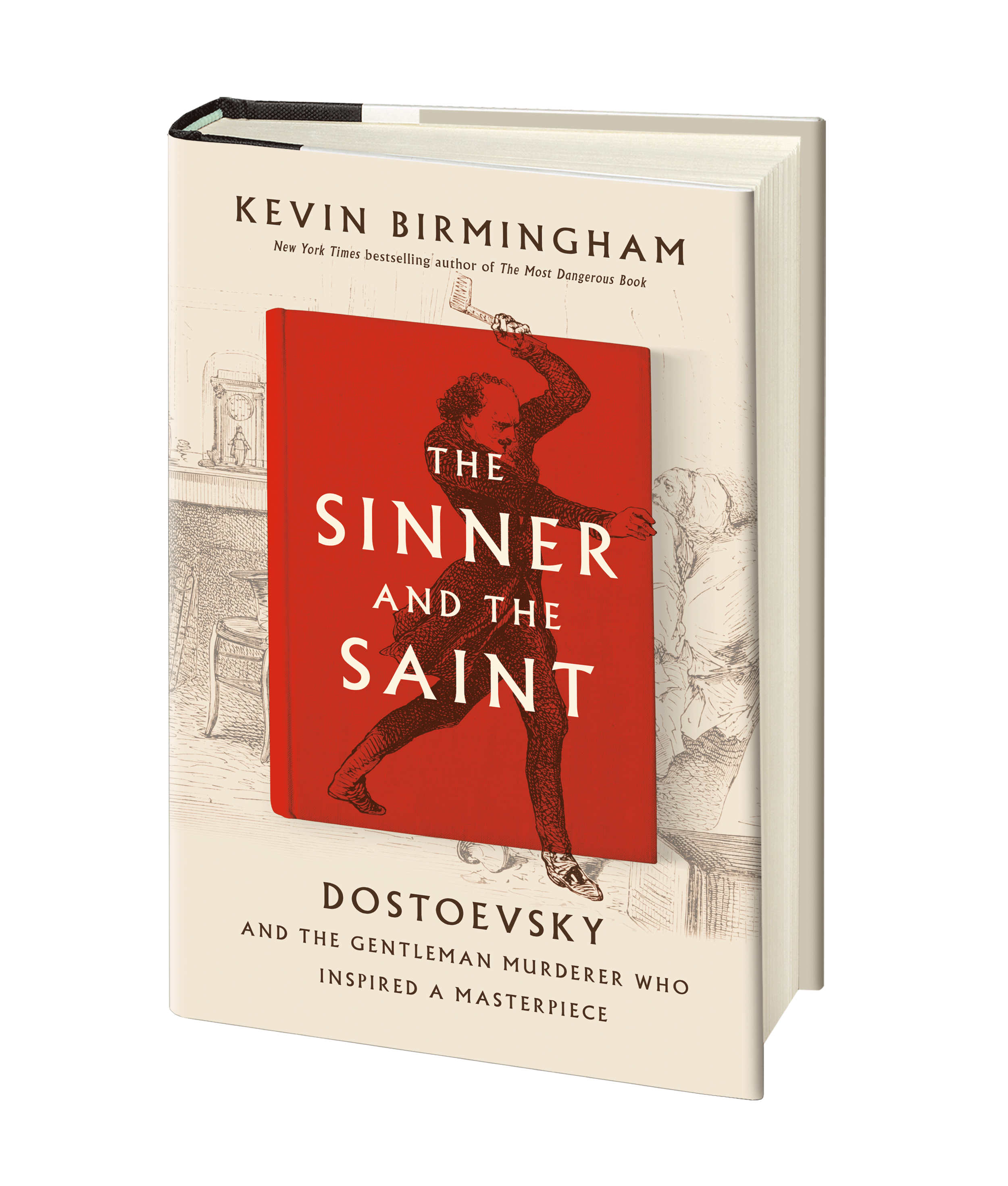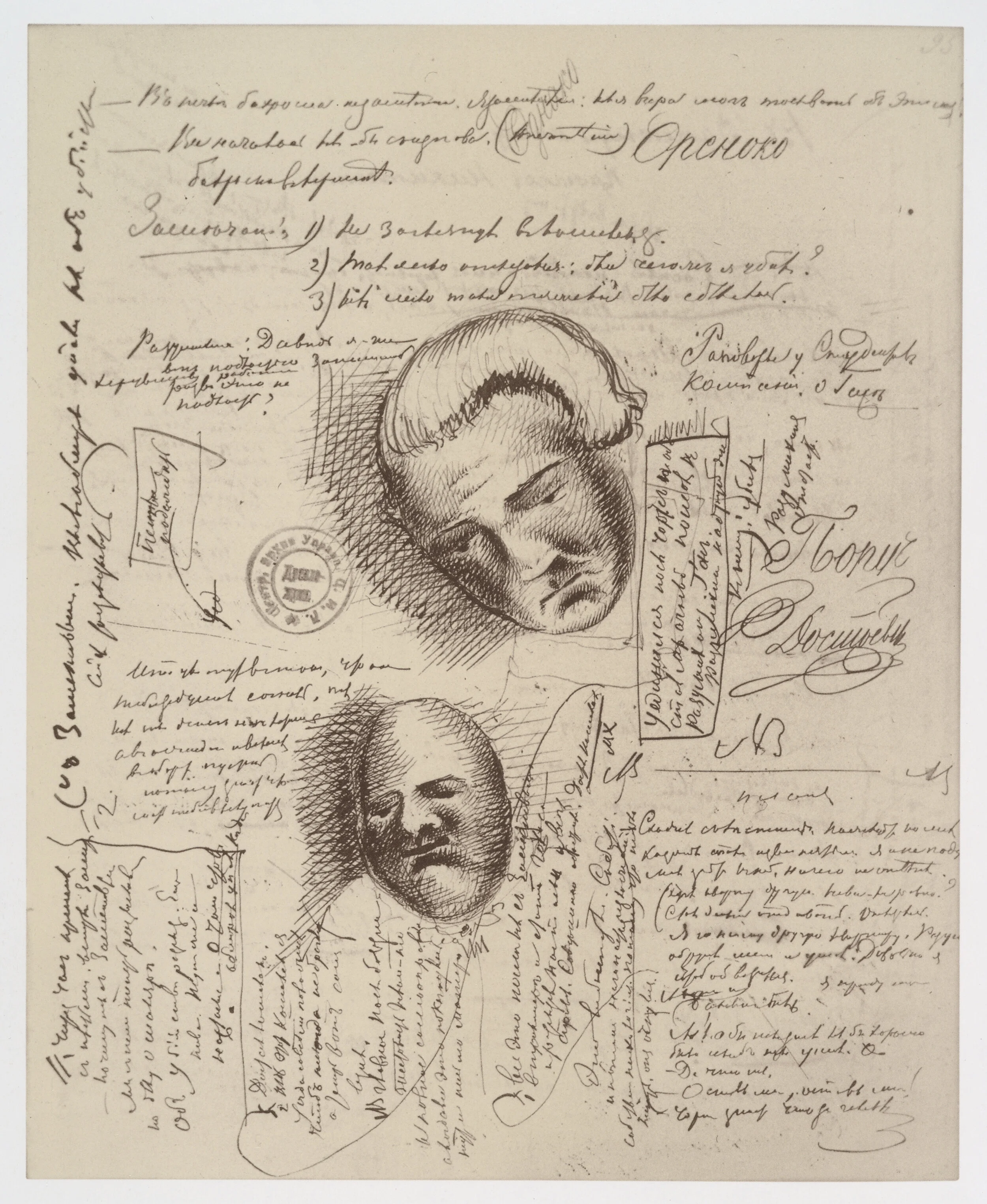From the New York Times bestselling author of The Most Dangerous Book, the true story behind the creation of another masterpiece of world literature, Fyodor Dostoevsky's Crime and Punishment
Dostoevsky in 1862
The Sinner and the Saint is the deeply researched and immersive tale of how Dostoevsky came to write this great murder story—and why it changed the world. As a young man, Dostoevsky was a celebrated writer, but his involvement with the radical politics of his day condemned him to a long Siberian exile. There, he spent years studying the criminals who were his companions. Upon his return to St. Petersburg in the 1860s, he fought his way through multiple hardships (gambling addiction, debilitating debt, epilepsy, the deaths of loved ones, and literary banishment) to craft an enduring classic.
Lacenaire on Trial
The germ of Crime and Punishment came from the sensational story of Pierre François Lacenaire, a notorious murderer who charmed and outraged Paris in the 1830s. Lacenaire was a glamorous egoist who embodied the instincts that lie beneath nihilism, a western-influenced philosophy inspiring a new generation of Russian revolutionaries. Dostoevsky began creating a Russian incarnation of Lacenaire, a character who could demonstrate the errors of radical politics and ideas. His name would be Raskolnikov.
Lacenaire shaped Raskolnikov in profound ways, but the deeper insight, as Birmingham shows, is that Raskolnikov began to merge with Dostoevsky. The novelist was determined to tell a murder story from the murderer's perspective, but his character couldn't be a monster. No. The murderer would be chilling because he wants so desperately to be good.
The writing consumed Dostoevsky. As his debts and the predatory terms of his contract caught up with him, he hired a stenographer to dictate the final chapters in time. Anna Grigorievna Snitkina became Dostoevsky's first reader and chief critic and changed the way he wrote forever. By the time Dostoevsky finished his great novel, he had fallen in love.
Crime and Punishment advanced a revolution in the way we understand consciousness in the modern world, and it began the greatest phase of Dostoevsky's career. The Sinner and the Saint now gives us the thrilling and definitive story of that triumph.
From Dostoevsky’s Crime and Punishment notebooks.
Winner of the 2016 Truman Capote Award for Literary Criticism
Winner of the 2015 PEN New England Award for Nonfiction
“The best story that’s told in Mr. Birmingham’s The Most Dangerous Book: The Battle for James Joyce’s Ulysses, however, may be that of the arrival of a significant young nonfiction writer. Mr. Birmingham... appears fully formed in this, his first book. The historian and the writer in him are utterly in sync. He marches through this material with authority and grace, an instinct for detail and smacking quotation and a fair amount of wit. It’s a measured yet bravura performance.”
—Dwight Garner, The New York Times
“A great story—how modernism brought down the regime of censorship—told as a great story. Kevin Birmingham's imaginative scholarship brings Joyce and his world to life. There is a fresh detail on nearly every page.”
—Louis Menand, Pulitzer prize-winning author of The Metaphysical Club
“This brilliant fusion of literary biography and cultural history tells two heroic narratives--Joyce's struggle to write his masterpiece despite poor health and constant economic woes, and the epic legal battle to publish the book in the face of strict obscenity laws. Birmingham is a wonderful writer, able to turn apparently dry subjects into exciting narrative prose.”
—Tom Perrotta, author of The Leftovers and Little Children
“The story of the sufferings of James Joyce’s Ulysses under government censorship and obscenity laws has never been better told than by Kevin Birmingham in this eloquent, deeply researched book. Birmingham takes readers on a vivid journey through the conditions that shackled and, ultimately, liberated Joyce’s masterpiece. Combining fluent narrative and fresh discovery, this book brings to life a lost world of little magazines, literary patronage, postal and customs laws, vice society raids, and courtroom heroics.”
—Robert Spoo, author of Without Copyrights: Piracy, Publishing, and the Public Domain
“The Most Dangerous Book is riveting narrative nonfiction, populated with enough real larger-than-life characters and twists to make a fiction writer envious. Through Kevin Birmingham's masterful voice and impeccable research, this story of a singular book that changed the world proves in dramatic fashion that the history of literature is not a landscape but a battlefield.”
—Matthew Pearl, New York Times bestselling author of The Dante Club
For more than a decade, the book that literary critics now consider the most important novel in the English language was illegal to sell, advertise, import or distribute in most of the English-speaking world. James Joyce’s big blue book, Ulysses, ushered in the modernist era and changed the novel for all time. But the genius of Ulysses was also its danger: it omitted absolutely nothing. All of the minutiae of Leopold Bloom’s day, including its unspeakable details, unfold with careful precision in its pages. The New York Society for the Suppression of Vice immediately banned the novel as “obscene, lewd, and lascivious.” Joyce, along with some of the most important publishers and writers of his era, had to fight for years to win the freedom to publish it. The Most Dangerous Book tells the remarkable story surrounding Ulysses, from the first stirrings of Joyce’s inspiration in 1904 to its landmark federal obscenity trial in 1933.
Literary historian Kevin Birmingham follows Joyce’s years as a young writer, his feverish work on his literary masterpiece, and his ardent love affair with Nora Barnacle, the model for Molly Bloom. Joyce and Nora socialized with literary greats like Ezra Pound, Ernest Hemingway, T. S. Eliot and Sylvia Beach. Their support helped Joyce fight an array of anti-vice crusaders while his book was disguised and smuggled, pirated and burned in the United States and Britain. The long struggle for publication added to the growing pressures of Joyce’s deteriorating eyesight, finances and home life.
Salvation finally came from the partnership of Bennett Cerf, the cofounder of Random House, and Morris Ernst, a dogged civil liberties lawyer. With their stewardship, the case ultimately rested on the literary merit of Joyce’s master work. The sixty-year-old judicial practices governing obscenity in the United States were overturned because a federal judge could get inside Molly Bloom’s head.
Birmingham’s archival work brings to light new information about both Joyce and the story surrounding Ulysses. Written for ardent Joyceans as well as novices who want to get to the heart of the greatest novel of the twentieth century, The Most Dangerous Book is a gripping examination of how the world came to say yes to Ulysses.





